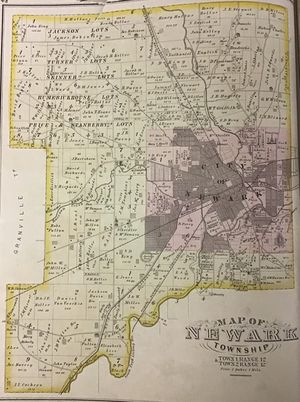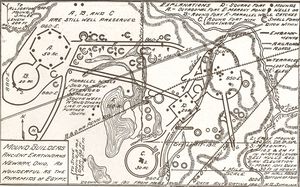Newark Township
The historic area encompassed by the nineteenth-century township included the points of confluence of three major county waterways: Racoon Creek, the North Fork of the Licking River and the South Fork of the Licking River. These converged within the close vicinity of one another leading to the founding of Newark city in the space. Several smaller runs fed into the larger streams making the area of Newark Township a "funnel-shaped basin" in the words of N.N. Hill; hills stand to the northeast and northwest which give way river bottoms as one moves southward. [1] A final series of hills stand on the southern bank of the South Fork in the extreme southeast corner of the original township.
Contents
Moundbuilders and Native American settlement
Nineteenth-century chroniclers marveled at the size of scope of the large earthworks, but also at the sheer number of smaller monuments. N.N. Hill recorded that "Cherry Valley seems to have been literally filled with them [earthworks and mounds], and they were thickly placed over a broad territory, including the site of the city of Newark and much of the Racoon valley, while as Mr. Park says, there are a hundred or more mounds on the surrounding hills that overlooked this great mound city in this valley." [2] This impressive landscape was irrevocably altered after the arrival of European settlers to the area. The 1914 Archaeological Atlas of Ohio noted only thirty-five ancient structures left in the township. [3] The growth of Newark, agricultural production, the construction of the canal and railroads – each took their toll on the mounds and earthworks. The survival of the Great Circle and Octagon Earthworks took the conscience effort by nineteenth-century leaders to hold those spaces for common use and lead to their preservation.
Early European Settlement
European settlement in the region begins in 1801 with the arrival of several families: Parr, Macauly, and Danner. The Parrs settled south of the junction of the North and South forks of the Licking River. The Macaulys and Danners built the township's first mill along Ramp Creek. After this initial wave, the pace of new arrivals increased. William C. Schenck laid out a plan for Newark in 1802 with seven inhabitants. The village's first business, Black's Tavern opened on the central square in 1804. [4] Schenk planned for the new village to lie within the area bounded by the three streams with Schenk providing for a large public square. This forward-looking planning would provide Newark with a large space around which the town could grow. At the time, the entire area remained a part of an expanded Fairfield County. [5]
In the fall of 1802, a larger group of families moved to Newark and Cherry Valley. An extended family named Belt were prominent among that group. "Little" John Belt helped to another mill which would become known as the Buskirk Mill. [6] Newark Township became the seventh township in newly formed Licking County in 1810. [7]
Newark
Newark was founded and surveyed by William C. Schenck in 1802 at the point area where the Licking Rivers and Raccoon Creek converged. The town was named after the city of Newark in Schenck's native New Jersey. The village of Newark was incorporated in 1826, almost a quarter century after its founding. The village grew into a city in the mid-nineteenth century as it became of center of transportation with the Ohio and Erie Canal passing through the city center in the 1820s and the arrival of railroad line in 1852. The proximity to the National Road made Newark vital transshipping point for goods and people moving across Ohio. In the last decade of the nineteenth century and first decade of the twentieth century, Newark grew into a regional hub for manufacturing with prominent manufacturing in glass, stoves, cigars and a variety of other goods. The added asset of two railroad lines and an electric car line led Newark to be a bustling city of 25,000 inhabitants by 1910. Newark would maintain its reputation as a manufacturing and production center into the 1960s with a corresponding growth in population and area.
Heath
The growth of the village Heath began in Newark Township, and spread to the surrounding townships, such as Licking Township. Heath had an industrial past long before it was an incorporated municipality; the Pure Oil refinery, Kaiser Aluminum, and Rockwell-Standard Company all developed in the area and predate the founding of Heath. [8] Incorporated as a village in 1952 and attaining the rank of city by 1965, Heath grew quickly as a suburb of Newark. In addition to industry, Heath also benefited from the presence of the Newark Air Force Base, as well increased commercial development associated with the opening of Indian Mound Mall in 1986. [9] The northwestern section of Licking Township—East of the Licking River and North of the confluence of the Licking with the Dutch Fork and west of Franklin Avenue—is now part of the city of Heath.
Ghost Towns
Over time, Newark grew and absorbed Lockport. Newspaper articles from April 2 and April 9, 1869 indicate that Lockport was annexed into Newark at that time, along with sections of land around Racoon Creek. This brought the administrative independence of the village to an end. [14] Lockport became the Seventh Ward of the town of Newark, but many residents continued to refer to that section of Newark by its old village name. [15] The area of Lockport comprised the space west of present-day Union Street, south of West Main Street, and north of Wehrle Avenue with sections lost in the expansion of Ohio State Route 79.
Hayesburg, or Whittle Point, was a proto-settlement that developed to the north of Downtown Newark. Originally settled by a family named Hayes, the location was known for a tavern and a schoolhouse that stood near the convergence of Mount Vernon Road and Elmwood Avenue. Perhaps better understood as a landmark or "locality," Whittle Point remained a locational reference for the people of Newark long after it became of part of the growing city. [16]
Dogtown is less a Ghost Town than a local legend; according to early local residents, the village was located on the east bank of the North Fork of the Licking River and said to be inhabited by beings that were half man and half dog. [17] Brandt Smythe claimed that Dogtown was sited at East Newark, directly across the North Fork from Newark town. Smythe also provided a more refined legend of Dogtown with a claim that litters of dogs were born there that were half human. If accurate and Dogtown was in fact the precursor to the West Newark neighborhood, this could add a pejorative connotation to the legend of Dogtown and its "hybrid" residents. [18]
Annexations
After more than two centuries of growth, Newark city now encompasses most of the former territory of Newark Township. Between 1945 and 1965, Newark annexed 4.6 square miles of Newark Township, including a large swath of land extending out West Main Street to Cherry Valley. This led to the merger of the township school districts in 1958. [19] The annexations continued and the remaining parts of the township lie to the northwest and northeast of Newark. These noncontiguous sections include stretches along Price and Sharon Valley Roads and Martinsburg and Cedar Run Roads. A series of annexations spanning decades has left the township with a smaller footprint and a population less than 2000 residents by the 2010 census. [20]
J.G.
Return to Townships and Communities main page.
References
- ↑ Hill, N., History of Licking County, (1881), 530
- ↑ Hill, N., History of Licking County, (1881), 527
- ↑ Mills, W., Archaeological Atlas of Ohio, (1914), 45
- ↑ Howe, H., Historical Collections of Ohio, (1854), 293
- ↑ Hill, N., History of Licking County, (1881), 535-536
- ↑ Hill, N., History of Licking County, (1881), 536
- ↑ Smucker, I., Centennial History of Licking County, 1876, 20
- ↑ Wilkin, J., Heath, Ohio: Hometown Memories, (2001), 41-48
- ↑ Wilkin, J., Heath, Ohio: Hometown Memories, (2001), 61-63, 100-101
- ↑ Ohio Ghost Towns: No 44 Licking County, ed. Helwig and Helwig, (1998), 114
- ↑ Bevan, J., "Map of the City of Newark, Licking Co., Ohio," (1853)
- ↑ Smythe, B., Early Recollections of Newark, (1940),34
- ↑ Albright, E., "Business Begun 80 Years ago in Lockport Still Carried on by Son of the Founder," Newark Advocate, May, 4, 1938
- ↑ "Annexation," Newark Advocate, Apr. 2, 1869, 3; Newark Advocate, Apr. 9, 1869, 3
- ↑ "The Truth Teller," Newark American Tribune, Aug. 23, 1901, 7
- ↑ Smythe, B., Early Recollections of Newark, (1940), 35; Brister, E., Centennial History of Newark, (1909), 417-418
- ↑ Ohio Ghost Towns: No 44 Licking County, ed. Helwig and Helwig, (1998), 65; Kingery, G., A Beginning, (1967), 9
- ↑ Smythe, B., Early Recollections of Newark, (1940), 33
- ↑ "How Newark's Grown Since World War II," Newark Advocate, Feb. 11, 1965, 17
- ↑ https://lickingcounty.gov/civicax/filebank/blobdload.aspx?BlobID=49110


